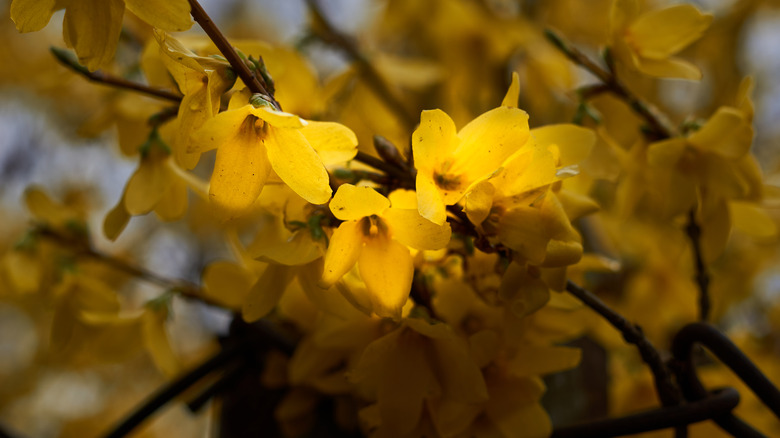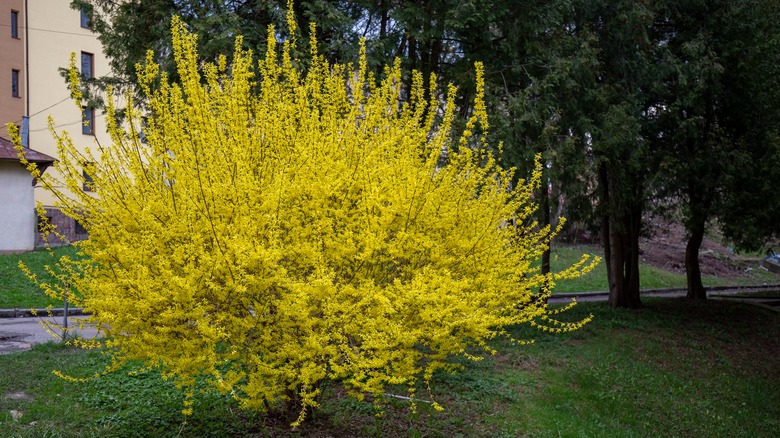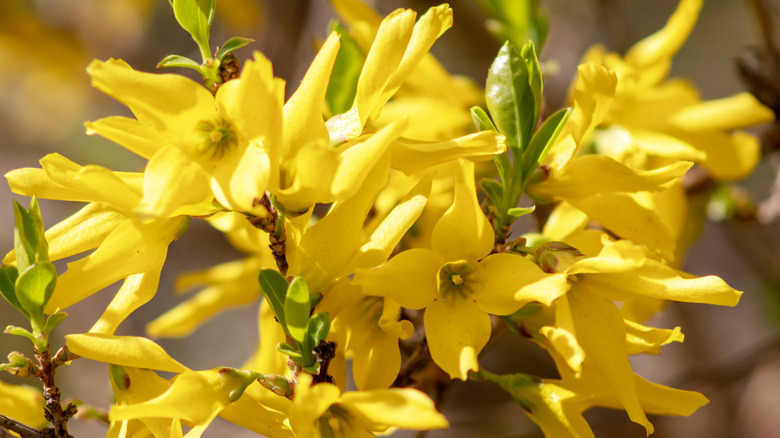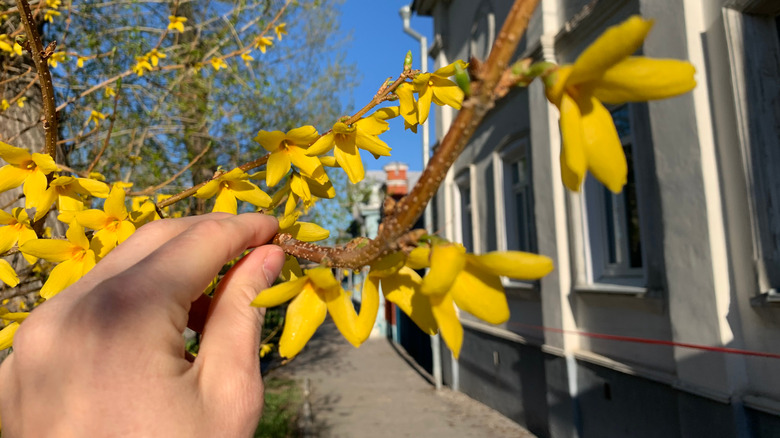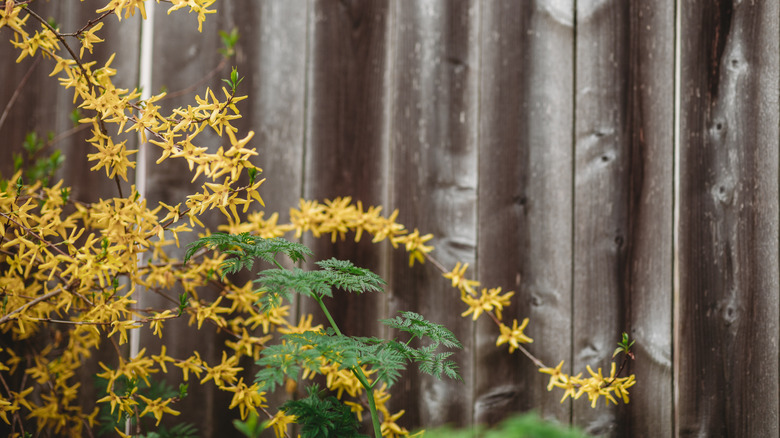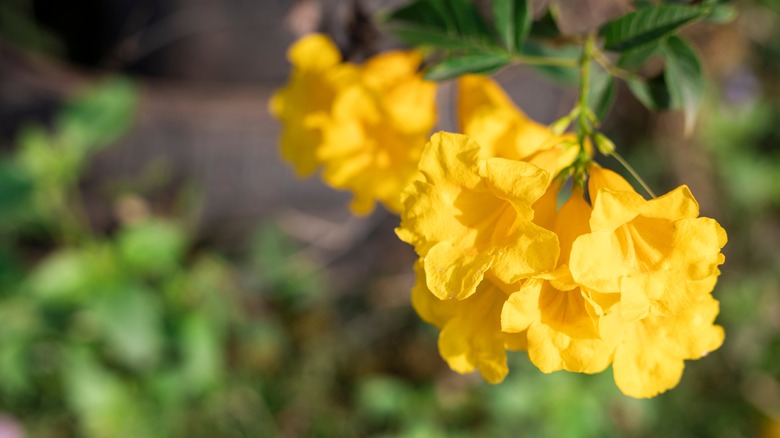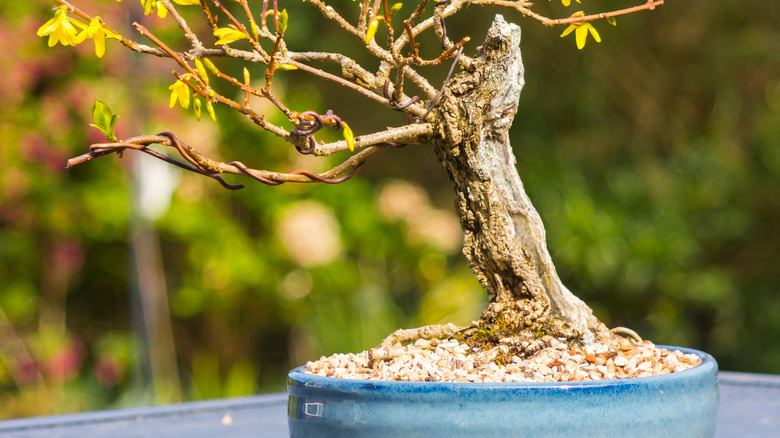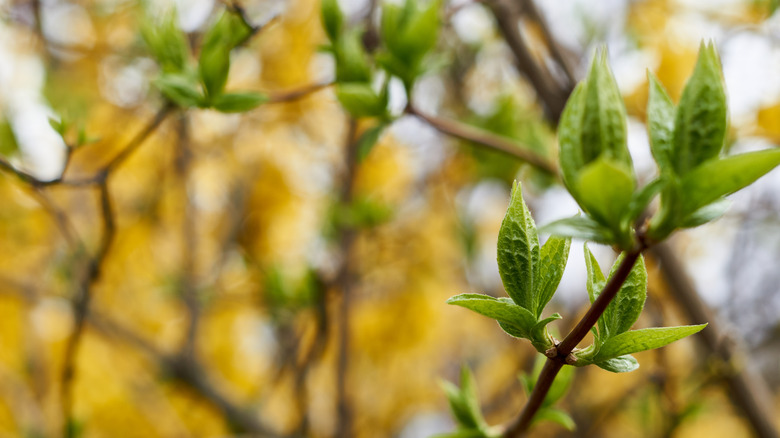How To Grow And Take Care Of Forsythia Plants
When it comes to growing forsythia, it's all about timing and arrangement, with early spring and mid-fall being the optimum periods, depending on your hardiness zone. Forsythia is one of the first cultivars to bloom in the spring. The cheerful yellow flowers delight us as soon as the weather warms up, appearing before the leaves on this deciduous perennial bush with arching branches.
The forsythia plant is an Oleacea family genus, just like the olive tree. This family consists of 10 species belonging to eastern Asia and one native to southeastern Europe. Among the forsythia types, F. suspensa and F. viridissima are the two most common. They are deciduous shrubs with gray-brown bark that bloom in early spring with bright lemon yellow pea-like blooms, and they thrive in full or part sun in USDA zones 5 to 9. As mentioned by Garden Guides, some forsythia types look fantastic on the edge of a wall or slope, while other varieties are upright and excellent for fast-growing, easy-care hedgerows and back-of-the-border color. There are also many forsythia dwarf types, and most of them grow as large as 12 inches by 10 inches and live for up to 50 years.
How to use forsythia plants in garden
Forsythia is a shrub that can be used in a plethora of ways. It would make a stunning specimen plant on its own, perhaps with a few spring bulbs at its feet; still, it is able to do much more than just stand around and looking nice. According to Happyy Garden, forsythias can serve a variety of roles in the garden, including defining a property perimeter, walling in a private garden room, blocking an unwanted view, and hiding a piece of your outdoor space from passers-by. In addition, forsythia fruits are commonly used in Chinese traditional medicine to treat bacterial infections and upper respiratory disorders due to their antipyretic and anti-inflammatory properties. These mixtures usually involve honeysuckle flowers (Lonicera), alongside other natural ingredients.
Forsythia plants can be cultivated formally or informally, per Gardener's Path. Still, if you have large bushes with weeping branches or a mix of arching and upright branches in the garden, you should always grow it informally. Medium-sized types with a good growth habit are particularly effective in medium-height mixed hedges with diverse bushes with comparable cultural requirements. On the other hand, cold-hardy forsythia is a landscape workhorse that is easy to establish because it can withstand dryness and salt; plus it proliferates, sometimes 2 feet or more per year, depending on the type. Forsythia definitely passes the test regarding dependability; you can be confident that it will serve you well if you take adequate care of it.
How to grow forsythia plants
Forsythia varieties grow in soil with a pH of 6.8 to 7.7 in USDA zones 4 through 9. This plant usually simply needs full sun and well-drained soil to thrive — forsythia plants that receive more sunlight will produce more flowers. It's also essential to plant forsythia early in the fall to allow its roots to grow before it goes dormant in late October. However, if you reside in an area where freezing temperatures aren't a problem, you can plant it all year. Again, refer to the plant species for precise details, as different kinds may perform better in different situations.
When it comes to planting forsythia in the ground, spacing is crucial. Consider how your forsythia will be utilized in your landscape — if it will be used for privacy, place the bushes closer together. Forsythia, like many plants, can be grown from stem cuttings. The Gardener's Network says first, cut 4- to 6-inch new growth stems from the plant's outside margins, then remove the lower 3 inches of the stems' leaves. To keep the stem's integrity, make sure to use sharp, sterilized shears. Keep the ends wrapped in a damp paper towel in a dark, opaque plastic bag. Next, place the bottom end of the stem in a pot with drainage holes and a half-perlite, half-peat moss mixture within 24 hours. Finally, cover it with clear plastic wrap and watch for new growth, which might take anywhere from one month to a growing season.
How to care for forsythia plants
Regularly watering a well-established forsythia is unnecessary; during prolonged dry spells, water the plant's top rather than the soil in the morning and evening. It would help to take your watering cues from the appearance of the plant: The forsythia is dehydrated and needs water if its leaves are withered and sagging. On the other hand, new plants will want a little more care. Water them regularly and get rid of any surplus liquid within 10 minutes to avoid moisture buildup. Furthermore, pruning a forsythia encourages new growth and increases the number of flowers it produces. Remove any branches that aren't producing flowers and thin out the shrubs in the late winter or early spring; if you wait too long, the new growth may freeze.
One thing to keep in mind about forsythia care is that it prefers to be in direct sunlight, Gardenista mentions. You will notice a considerable drop in overall development if the plant grows in the shadows. In that case, try moving it to a spot where it will receive more sunshine. You must ensure that your forsythia receives at least six hours of direct sunlight daily. However, keep in mind that the plant may tolerate a little less sun than this. On the other hand, if you wish to stop the forsythia shrub from growing, you should decrease its sunlight.
Varieties of forsythia plants
When it comes to planting the perfect forsythia for your garden, you should choose the plants from a nearby plant nursery with the desired characteristics. According to the University of Wisconsin-Madison, most commercially available forsythia plants are grown from cuttings. Therefore, it's ideal to buy forsythia in the early spring or the fall, when the best perennial plant selection is available.
-
"Beatrix Farrand": This 8- to 10-foot-tall shrub blooms in a brilliant golden yellow. This cultivar is a triploid forsythia derived from an F. x intermedia selection that was chemically treated to create this hybrid and then backcrossed with F. x intermedia. It outperforms other forsythia cultivars in bloom size, vigor, and overall habit.
-
"Karl Sax": This is a tetraploid cultivar that's a bushier but shorter version of "Beatrix Farrand" at around 6 feet tall. This type of forsythia blooms about two weeks later than other forsythias and also has golden-yellow flowers.
-
"Lynwood": This heavy bloomer cultivar is also known as "Lynwood Gold" and has an upright growth habit with yellow blooms that are slightly lighter than other species. It reaches a height of 8 to 10 feet and a width of 6 to 8 feet.
- "Arnold Giant": This compact plant reaches a height of 5 feet and a width of 5 feet. It is a tetraploid cultivar derived from a Spectabilis cultivar seedling. "Arnold Giant" forsythia has a more upright shrub habit with larger, thicker, and darker green leaves than other cultivars.
Are forsythia plants toxic?
Because the forsythia plant is also known as "Golden Bells," it is often confused with poisonous butterfly plants such as "Cytisus" and "laburnum" — which both have yellow blooms, though they bloom later than forsythia. While laburnum, like some other legumes, contains the deadly cytisine (which can kill infants at a dose of three to four pods), forsythias are listed as non-toxic plants. According to Treehozz, forsythia is not poisonous to pets and humans. However, there is a distinction between non-toxic and edible. Some people claim to consume forsythia blossoms, but only in small quantities because the petals can have a bitter taste.
Moreover, the fruit of forsythia suspensa is used to treat bronchiolitis, tonsillitis, sore throat, fever, gonorrhea, and general inflammation and is considered one of the 50 fundamental herbs in Chinese herbology. Foragers will be interested to know that the blossoms can create lactose (the milk sugar); still, lactose forsythia flowers are yet to be approved by the scientific community because they are rarely produced in other natural sources other than milk. Some people also use the forsythia blooms as a cheerful garnish and provide color to salads.
How to repot forsythia plants
Unlike many shrubs, forsythia produces several upright shoots from its root ball rather than a single trunk: Therefore, you must dig around all of the slender stems to extract the entire root ball when repotting forsythia. Still, Do It Yourself recommends waiting until the plant has finished blooming — normally in mid to late April — but is still active, and watering it well in advance.
Using the edge of a sharp spade, trace a circle around the forsythia shrub. The circle should be at least 12 inches in diameter and extend beyond the outermost upright stems. Next, remove the root ball from the hole and place it on a tarp to dry. Wrap a damp towel around the root ball to keep it moist while you transport it to its new home. To increase soil drainage and add nutrients, mix organic materials into the soil, such as completed compost, leaf mold, or manure. Next, dig a hole with the same depth as the forsythia root ball and at least two times its diameter. Place the forsythia root ball in the planting hole and apply a 3- to 4-inch layer of bark chip mulch to the soil around the plant. Water the forsythia generously until the soil is equally moist but not soggy. Finally, during the first growing season, water about once a week to keep the soil moist from spring to fall. During droughts, water more often.
How to get your forsythia plants to bloom
There could be a couple of reasons why you aren't seeing forsythia's original colorful blossoms. According to Gardener's Path, improper pruning is one of the most common causes of a lack of blooms. Because forsythia blossoms on old wood, any pruning should be done before it blooms, so make sure to prune right after the flowers appear in the spring. You risk cutting off next year's blossoms if you wait until late summer or early fall, leaving you with a somewhat sparse bush for the next season.
Another reason your forsythia bush isn't flowering as well as it can is a lack of light. As mentioned, forsythia bushes require at least six hours of sunlight every day on average; a few days with less won't be a problem, though. Take some time to analyze how much light your plant receives if you have a few bothersome shrubs that aren't flowering. Trim back neighboring trees that may be blocking the sun to allow more light to reach your bush if possible and wait for its flowers to appear.
